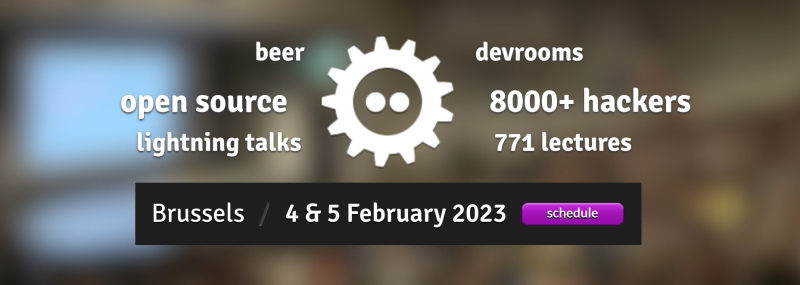
Every year, on the first weekend of February, a certain Brussels university campus livens up. There, you will find enthusiasts of open-source software and hardware alike, arriving from different corners of the world to meet up, talk, and listen. The reason they all meet there is the conference called FOSDEM, a long-standing open-source software conference which has been happening in Belgium since 2000. I’d like to tell you about FOSDEM because, when it comes to conferences, FOSDEM is one of a kind.
FOSDEM is organized in alignment with open-source principles, which is to say, it reminds me of an open-source project itself. The conference is volunteer-driven, with a core of staff responsible for crucial tasks – yet, everyone can and is encouraged to contribute. Just like a large open-source effort, it’s supported by university and company contributions, but there’s no admission fees for participants – for a conference, this means you don’t have to buy a ticket to attend. Last but definitely not least, what makes FOSDEM shine is the community that it creates.
FOSDEM’s focus is open software – yet, for hackers of the hardware world, you will find a strong hardware component to participate in, since a great number of FOSDEM visitors are either interested in hardware, or even develop hardware-related things day-to-day. It’s not just that our hardware can’t live without software, and vice-versa – here, you will meet plenty of pure software, a decent amount of pure hardware, and a lot of places where the two worlds are hard to distinguish. All in all, FOSDEM is no doubt part of hacker culture in Europe, and today, I will tell you about my experience of FOSDEM 2023.
What’s So Cool?
This year, FOSDEM happened from 4th to 5th of February, with almost ten thousand visitors from countries all over the globe, somewhat biased towards Western Europe close to Belgium. Nevertheless, people booked long flights, took trains and planned hotels well in advance – AirBnB and hotel rooms around get sold out quite a bit before the event. Why invest time into such a gathering? For a start, if you’re arriving on your own just to explore, there will be plenty of like-minded people for you to meet, exploration and talks to learn from, and warm memories afterwards. Not just that, however – this conference helps open-source communities gain their wings, and if you participate in an open-source project, even by virtue of using a programming language, there’s a whole new dimension in FOSDEM for you.
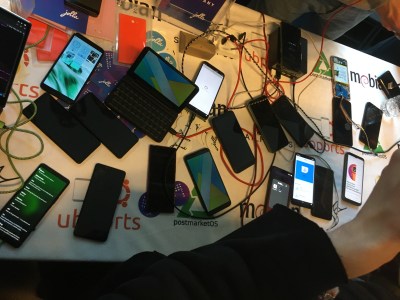 My first trip to FOSDEM, back in 2018, was to meet some open-hardware project developers and share experience about an idea of mine; once I got to the conference, the various talks got my attention, and FOSDEM’s volunteering system pulled me in during my free time. Next year, I myself was working on a small but interesting open-source hardware project, and I went to meet some contributors and to-be-users of mine, chatting about hardware throughout. A year afterwards, I didn’t have as much of a reason to go – but at this point, I just couldn’t miss it. Two “FOSDEM happening online” years passed, and I went back to Brussels, now making sure to bring a few friends so that more people could appreciate what makes this conference; perhaps, FOSDEM is just a bit addictive.
My first trip to FOSDEM, back in 2018, was to meet some open-hardware project developers and share experience about an idea of mine; once I got to the conference, the various talks got my attention, and FOSDEM’s volunteering system pulled me in during my free time. Next year, I myself was working on a small but interesting open-source hardware project, and I went to meet some contributors and to-be-users of mine, chatting about hardware throughout. A year afterwards, I didn’t have as much of a reason to go – but at this point, I just couldn’t miss it. Two “FOSDEM happening online” years passed, and I went back to Brussels, now making sure to bring a few friends so that more people could appreciate what makes this conference; perhaps, FOSDEM is just a bit addictive.
“Community” is likely the word I have in mind when it comes to what makes FOSDEM unique. The aura of FOSDEM never seems to fail to bring people that I’m interested in, it is why people come back, and it’s why some people volunteer throughout the event or even become staff to make FOSDEM possible year by year. There is no large corporation directing the event, and FOSDEM wouldn’t be much if it weren’t for everyone’s individual contribution, whether it’s giving a talk, being in a room listening, wandering around the stalls, standing at a stall talking to anyone interested in your project, helping at one of the infodesks, or being on standby throughout the weekend helping debug video streaming problems at a moment’s notice; everybody’s participation makes the open-source world shine just a bit more as a result.
Expected Pathways
When it comes to open-source communities, year after a year, FOSDEM doesn’t just familiarize people with open projects – it also brings the projects closer together. My priority is hardware, but as you might expect, the brightest examples of FOSDEM helping open-source projects grow, are in the open-source software area – and this year, Matrix is a great demonstration of what I mean by that.
Matrix is a fully open messaging platform that aims to take over every single proprietary messenger by force of open-source without compromise, and the takeover has been happening everywhere – from friend groups to entire governments. This year’s FOSDEM, Matrix had a blast – they did the “Matrix 2.0” main track talk, hosted a Matrix-dedicated devroom with talks throughout the weekend, had developers meet up and hack on various aspects, and delivered the message of Matrix to myriads of people beyond the core – all in all, it’s a social jet engine boost towards a future free of proprietary messengers. Now, this is a giant project, but thanks to ideas like the Birds of Feather rooms, small projects can have their own small get-together; also, any thematic talk can and often does turn into an impromptu project meetup afterwards.
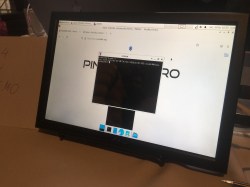
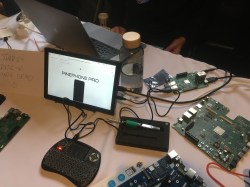
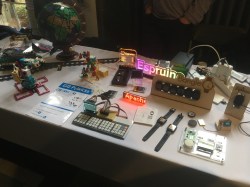
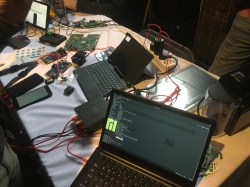
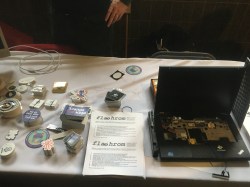
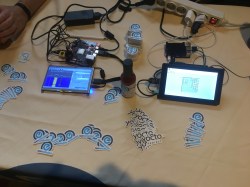
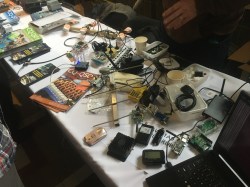
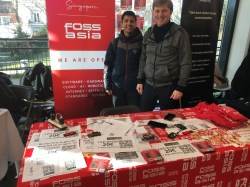
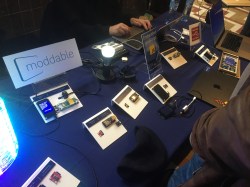
This kind of principle, of course, propagated throughout the FOSDEM’s hardware hacker front. For a start, there was the AW building, a must-visit area – not giant but nevertheless distinct, full of hardware project embassies and devrooms; to add to it, an extra dozen of heavily-hardware-adjacent tables could be found all throughout the campus. Of course, part of open-source software is the mobile OSes, and you’d expect the postmarketOS and the Linux on Mobile community around a desk absolutely full of smartphones of all kinds. However, there was way more – a ham radio enthusiast gathering, the coreboot/flashrom embassy, MicroPython, Espruino and embedded JavaScript tables, Automotive Linux, OpenHAB, and the OpenEmbedded/Yocto project table, all of them eager to talk with people who might be their users and just not know it yet, or already are users and would like to lift the LCD and nickname veil.
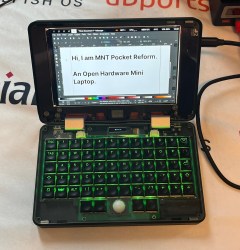
For instance, MicroPython’s ambassador has told me that throughout this year’s event, she’s met quite a few hardware-curious people who have either never heard of MicroPython or never got to try it, and were happy to find a table where they could actually see for themselves what MicroPython is about. Next to their desk, Pine64 took a large spotlight – with key members arriving from as far as Far East, at FOSDEM, you could meet the Pine64 in person, both the manufacturing and the community side. From the usual Pine offerings to developer-only boards, tech demos and a few yet-to-be-released gadgets like the Star64, the Pine64 desk was never free of people who wanted to take a look at genuinely open-source devices of all kinds. As I said, the hardware didn’t end in the AW building – for instance, FOSSASIA had a desk where they were showing the PSLAB, a small all-in-one benchtop lab device.
All of these are examples of how FOSDEM supports the hardware scene and how the hardware scene is an inseparable part of FOSDEM – however, that’s far from the only value FOSDEM provides for a hardware hacker.
Random Encounters
Hardware was a supporting component at many software desks too – for instance, the Jenkins table had a cute cluster of ARM devices with a neat 3D-printed frame that helped demo the features of Jenkins, the FreeBSD table had a “hardware hacking with FreeBSD” demo sporting a BeagleBone and a few breadboards, and the KDE table had a single-board computer with a touchscreen demoing their mobile device work. These are all apt examples of how some hardware hacking on the side can greatly boost a software project’s perceived coolness – through the pure power of metaphorical blinking LEDs shown being powered by this software project. We all know that pure hardware only gets you so far – which makes such collaborations crucial.
 However, you’d be missing out if you paid attention only to hardware-augmented things and not to the overall joyous open-source spirit that fills the campus. Whether it’s people in VLC hats or the PostgreSQL elephant wandering around, the impromptu hacking sessions at cafeteria tables, the unique energy in devrooms when the whole audience is listening to a speaker’s proudly delivered discoveries and software war stories – you are invited to participate in this atmosphere. You will learn of whole new areas of open software and hardware world, discover complexities that you might have never suspected to be there and gain respect for people dealing with them.
However, you’d be missing out if you paid attention only to hardware-augmented things and not to the overall joyous open-source spirit that fills the campus. Whether it’s people in VLC hats or the PostgreSQL elephant wandering around, the impromptu hacking sessions at cafeteria tables, the unique energy in devrooms when the whole audience is listening to a speaker’s proudly delivered discoveries and software war stories – you are invited to participate in this atmosphere. You will learn of whole new areas of open software and hardware world, discover complexities that you might have never suspected to be there and gain respect for people dealing with them.
You will also find things you never knew you wanted to find. For instance, every now and then, a far-away-country-based community sets up an embassy at FOSDEM – this year, I was surprised to find a table where a few Taiwan’s software world representatives were showing how they advance their own openness and education goals, make friends in the European open-source community. Also, at some point, I left one of the main buildings and found a sizeable group of people watching a small transparent balloon rise up – later, I learned that it was equipped with a LoRa transmitter! Such occurrences will be unique for everyone, and if you walk around the campus as FOSDEM unfolds around you, you will find something that fascinates you in particular.
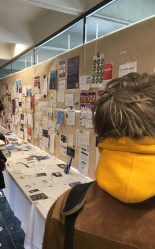 Naturally, every developer-populated community attracts people who are looking for developers, and you might just stumble upon some ways to get paid for what you already love doing, too. What if you are looking for a career change and just haven’t looked a good opportunity yet? Well, drop by the jobs board, a dedicated wall for job and contract advertisements, project pitches and, as a bonus, a sticker exchange. Or, perhaps, do you have a public good open-source project idea in mind, and something to show for it? The NLNet embassy is right there – they’re an organization that sponsors open-source projects in software and hardware areas, and if your project fits their criteria, you could get a grant to work on that one fundamental idea of yours.
Naturally, every developer-populated community attracts people who are looking for developers, and you might just stumble upon some ways to get paid for what you already love doing, too. What if you are looking for a career change and just haven’t looked a good opportunity yet? Well, drop by the jobs board, a dedicated wall for job and contract advertisements, project pitches and, as a bonus, a sticker exchange. Or, perhaps, do you have a public good open-source project idea in mind, and something to show for it? The NLNet embassy is right there – they’re an organization that sponsors open-source projects in software and hardware areas, and if your project fits their criteria, you could get a grant to work on that one fundamental idea of yours.
FOSDEM’s community has a way of surpassing your expectations if you give it a chance – and, of course, as with any self-respecting conference, the talks seal the deal.
Talks, Of Course
The “healthy mix of hardware and software” MO also applies to the talks, and I’ll give hardware the spotlight yet again – there’s more than enough for all of our tastes. For instance, this year, FOSDEM’s main track had participants dive into open-source chip design, browser-based maker tools and home automation, giving these topics a much-needed highlight. Aside from the main track, talks happen in thematic devrooms, with a few devrooms closely tied to hardware and a lot of pure software ones. The lightning talk areas have hardware talks peppered in, too – I’ve found the LibreSoC open System-on-Chip family, FPGA music synthesis, FOSSBot educational robot, and FabAccess (creative space access control system) talks to be engaging, short yet sweet.
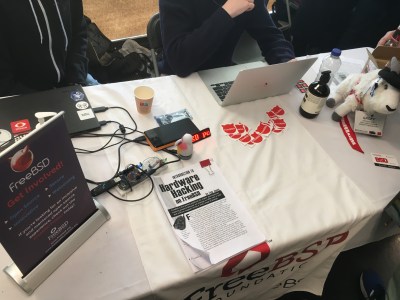 Ddevrooms are where it’s at for learning purposes – there, you can learn directly from developers on any given topic. Say, would you like to know just what the deal is with SecureBoot, TPMs and secure computing in general, without the everpresent FUD? There’s entire two devrooms (Secure Measured Boot and Open-Source Firmware) where you can learn directly from open-source developers tackling these, and they’ve been going on for a few years in some form. Are your hardware&software skills alone not enough to create devices that users enjoy interacting with? Drop by the Open-Source Design devroom to learn the under-taught basics of friendly design. The Embedded, Mobile and Automotive devroom will have you get close to the metal, from VoLTE and FPGA bitstreams, to Bluetooth mesh networks or reverse-engineering this and that, and way more – this is perhaps, one of the most immediately engaging devrooms for a Hackaday reader. Last but not least, if you ever wanted to learn about FOSS on mobile devices and the challenges associated with making our pocket devices free from proprietary nonsense, the namesake devroom has plenty to offer.
Ddevrooms are where it’s at for learning purposes – there, you can learn directly from developers on any given topic. Say, would you like to know just what the deal is with SecureBoot, TPMs and secure computing in general, without the everpresent FUD? There’s entire two devrooms (Secure Measured Boot and Open-Source Firmware) where you can learn directly from open-source developers tackling these, and they’ve been going on for a few years in some form. Are your hardware&software skills alone not enough to create devices that users enjoy interacting with? Drop by the Open-Source Design devroom to learn the under-taught basics of friendly design. The Embedded, Mobile and Automotive devroom will have you get close to the metal, from VoLTE and FPGA bitstreams, to Bluetooth mesh networks or reverse-engineering this and that, and way more – this is perhaps, one of the most immediately engaging devrooms for a Hackaday reader. Last but not least, if you ever wanted to learn about FOSS on mobile devices and the challenges associated with making our pocket devices free from proprietary nonsense, the namesake devroom has plenty to offer.
My view has always been that you can view all the talks afterwards, but you can’t walk around and meet people post-factum. However, it’s hard to deny that the talks will keep you entertained at a whim, and there will be some that you feel like you just won’t be able to miss. Perhaps, would you like to learn more about the infrastructure that runs FOSDEM?
Speaking About The Infrastructure
Whether you’d like to socialize during FOSDEM or it’s just that you can’t make the trip, all of the talks are livestreamed and recorded. It’s a simple statement, but consider the amount of devrooms, and the sheer volume will have you realize that these words have some serious backing to them; indeed, the video infrastructure has some technical spice to it. The recordings are up almost as soon as the conference ends, and the livestreams have all the remote attendants highly satisfied with their virtual trip. The infrastructure, whether networking, video, or the on-site volunteer coordination, has the event go without a hitch, evidently refined throughout the years by the FOSDEM core group – volunteers who have been there throughout the years and have taken up all the fundamental preparation and coordination tasks.
Of course, don’t forget, this is a community-driven conference, which means there’s plenty of hacker spirit at play while making things work this flawlessly. For example, during a peek behind the scenes, I was astonished that part of the FOSDEM video infrastructure stack includes a flock of 35 Thinkpads chugging away with lids half-open. Let’s face it – the results do speak for themselves, so it has to have been the best solution to whatever problem this part of the stack tackles.

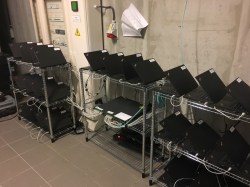
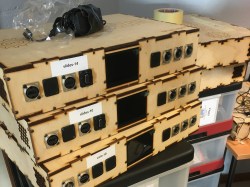
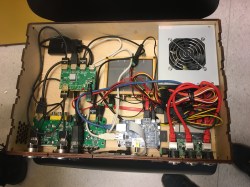
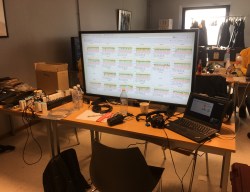
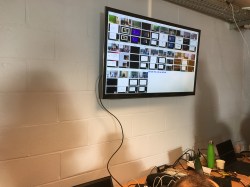
On the opposite side of the equation, another hacker spirit manifestation is something you can find in all devrooms sitting on presenter desks – these sizeable lasercut boxes, each equipped with a bunch of XLR, HDMI, VGA and Ethernet connectors, as well an LCD screen. You know there’s something important going on – and indeed, inside you find a combination of AV capture and processing boards, a single-board computer, and a PC power supply. These boxes have been a crucial element when making FOSDEM’s video stream work, and the exact SBC and AV board combination in use this year has been perfected over the years – providing stability, throughput and featurefulness that ultimately, only a DIY solution could reach.
Of course, it’s not just the core team that runs everything. If you’re a FOSDEM visitor and you have a bit of free time, be it Friday or Sunday evening, or throughout the conference; perhaps, your devroom of choice or an interesting talk also happens to need a herald – there’s a volunteer system that shows you which part of FOSDEM could use help, and lets you join in. Friday evening, in case you arrive to Brussels early enough, is the buildup – large amounts of Ethernet cables are rolled out from building to building, signage is attached, tables, chairs and posters are put where they belong. Sunday evening, as you might guess, is the cleanup event, when all of these changes are rolled back; there’s always a need for a spare pair of hands. Throughout the event, each devroom, talk and infodesk needs a group of volunteers, and if the volunteer system shows that one of them could use a few more people, it might just be your time to shine.
Until Next Year
Despite being an open-source software conference, FOSDEM has plenty of things to offer to hardware hackers, and the community that springs up throughout the weekend, makes it an unique place to be; I expect to keep coming back. This year’s FOSDEM is over, leaving us with a bouquet of videos to watch – next first weekend of February, it will be time for the 2024 installment, and perhaps, you’d also like to drop by and check it out for yourself!
Big purple FOSDEM logo upscaled by Andrew Shadura.
FOSDEM 2023: An Open-Source Conference, Literally
Source: Manila Flash Report
0 Comments